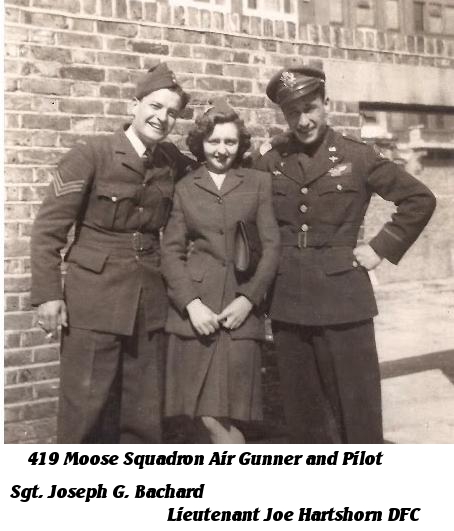
 Following the normal of training sequence then in place he completed his Wireless training and in May of 1941. It wasn’t until
March 29th 1942 that LAC Bachand found himself at No.7 Bombing and Gunnery School (7 BGS) in Paulson, Manitoba.
Following the normal of training sequence then in place he completed his Wireless training and in May of 1941. It wasn’t until
March 29th 1942 that LAC Bachand found himself at No.7 Bombing and Gunnery School (7 BGS) in Paulson, Manitoba.
 During the interim he was stationed at various training bases within the province of Quebec.
During the interim he was stationed at various training bases within the province of Quebec.
Arriving overseas in June of ’42 and as all RCAF personnel did was posted to No. 3 Personnel Reception Centre located in Bournemouth,
a sea side resort on the South coast of England which was in easy reach of the Luftwaffe just across the channel. Where everyone awaited their postings or further training. And so again Joseph Bachand found himself at No. 7 Air Gunner School, although this time it was at RAF Stormy Down, near Pyle.
Returning in early
 November to the oddly named Air Crew Disposal Wing Brighton
Which was just one of the many hotels in Brighton. Where he played the military game of
waiting, eventually posted to “R” Depot in Houghton Green, Lancashire. These Dispatch Centers were a further step towards frontline postings.
From January 19 to June 22 1943 (5 months) he posted to No. 23 OTU. Operational Training Unit at Throckmorton, Worcestershire. OTU's were where
the RAF and RCAF trained the crews to work as a team. Up till this time courses were focused on only the trade of the individual airman with little if any
interconnecting with other aircrew trades.
November to the oddly named Air Crew Disposal Wing Brighton
Which was just one of the many hotels in Brighton. Where he played the military game of
waiting, eventually posted to “R” Depot in Houghton Green, Lancashire. These Dispatch Centers were a further step towards frontline postings.
From January 19 to June 22 1943 (5 months) he posted to No. 23 OTU. Operational Training Unit at Throckmorton, Worcestershire. OTU's were where
the RAF and RCAF trained the crews to work as a team. Up till this time courses were focused on only the trade of the individual airman with little if any
interconnecting with other aircrew trades.
OTU's were where crews formed up, all aircrew trades would assemble and mix around sorting themselves out. As one veteran put it, "it was like going to your first dance
everyone milled about in groups of friends, while trying to find a partner and not be left out of the party". It always worked out best it seems if the individuals made their choices, but of course it was the
pilot of the aircraft who would make the final decisions. Then it was his duty to weld them into an effective team. As a Wireless Operator /Gunner Sgt. Bachand would become an important member of the team
both duties would demand the full attention of Joseph. Now flying in an actual bomber with a full crew that would rely on him to work and possibly repair the radio while the dangers of front line actions were going on all around him.
The missions were at times considered "milk runs", although there were still the dangers associated with raids they would later be called on to be part of.
Bad weather, roving fighters and flak still were the daily threats to the crews.
The main aircraft in use at this time in the OTU units was the twin engine Wellington, the crew would now begin a new set of training procedures at the
Heavy Unit Conversion bases. The larger "Heavies" all had four engines and required two additional airmen, another gunner and a new trade would join the team,
the Flight Engineer. The Flight Engineer would be the right hand man of the pilot. And so again, now as an expanded crew they would take part on operations to smooth out any
wrinkles of flying a larger aircraft and learn how to use their new charge to it's best
advantage on their future missions.
On July 15th 1943 WO II Bachand is posted to 419 Moose squadron. Between July 27th to February 12th he had
flown on 16 previous operations with F/O Laidlaw and crew. When on the night of February 12/13 1944
on a mine laying mission to Borkum Island when the aircraft was lost. The lost was a mysterious one. Five other crews in the area
saw no enemy aircraft or other enemy action such as flak. No mayday was received back from the aircraft and no
explosions were seen by the other aircraft. No Luftwaffle records show any claims for aircraft during that time and place.
And so this experinened crew and their aircraft disappeared somewhere after there leaving their base. Leaving no trace or record of
what happened.
